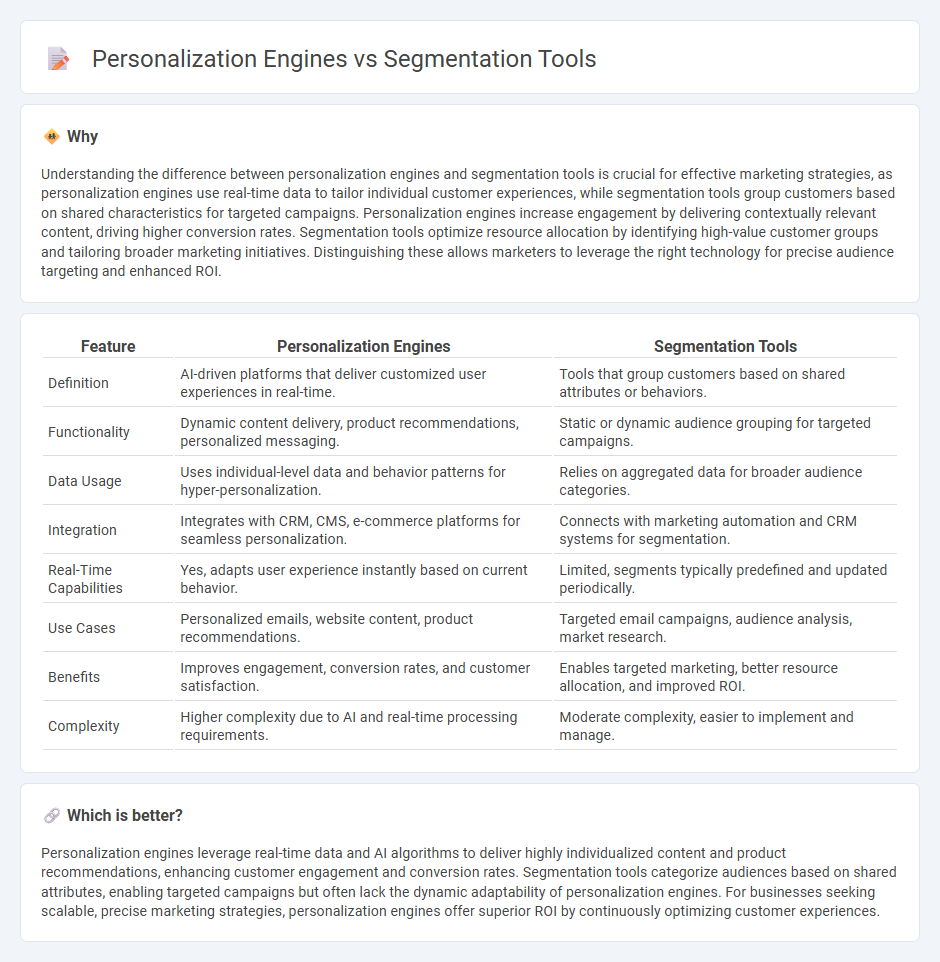
Personalization engines use real-time data and machine learning algorithms to deliver individualized customer experiences, increasing engagement and conversion rates. Segmentation tools categorize audiences into distinct groups based on demographics or behavior, enabling targeted marketing strategies. Discover how leveraging these technologies can transform your marketing approach.
Why it is important
Understanding the difference between personalization engines and segmentation tools is crucial for effective marketing strategies, as personalization engines use real-time data to tailor individual customer experiences, while segmentation tools group customers based on shared characteristics for targeted campaigns. Personalization engines increase engagement by delivering contextually relevant content, driving higher conversion rates. Segmentation tools optimize resource allocation by identifying high-value customer groups and tailoring broader marketing initiatives. Distinguishing these allows marketers to leverage the right technology for precise audience targeting and enhanced ROI.
Comparison Table
| Feature | Personalization Engines | Segmentation Tools |
|---|---|---|
| Definition | AI-driven platforms that deliver customized user experiences in real-time. | Tools that group customers based on shared attributes or behaviors. |
| Functionality | Dynamic content delivery, product recommendations, personalized messaging. | Static or dynamic audience grouping for targeted campaigns. |
| Data Usage | Uses individual-level data and behavior patterns for hyper-personalization. | Relies on aggregated data for broader audience categories. |
| Integration | Integrates with CRM, CMS, e-commerce platforms for seamless personalization. | Connects with marketing automation and CRM systems for segmentation. |
| Real-Time Capabilities | Yes, adapts user experience instantly based on current behavior. | Limited, segments typically predefined and updated periodically. |
| Use Cases | Personalized emails, website content, product recommendations. | Targeted email campaigns, audience analysis, market research. |
| Benefits | Improves engagement, conversion rates, and customer satisfaction. | Enables targeted marketing, better resource allocation, and improved ROI. |
| Complexity | Higher complexity due to AI and real-time processing requirements. | Moderate complexity, easier to implement and manage. |
Which is better?
Personalization engines leverage real-time data and AI algorithms to deliver highly individualized content and product recommendations, enhancing customer engagement and conversion rates. Segmentation tools categorize audiences based on shared attributes, enabling targeted campaigns but often lack the dynamic adaptability of personalization engines. For businesses seeking scalable, precise marketing strategies, personalization engines offer superior ROI by continuously optimizing customer experiences.
Connection
Personalization engines leverage segmentation tools to analyze customer data and create targeted audience groups based on behaviors, demographics, and preferences. This connection enables brands to deliver highly relevant content and offers tailored to specific segments, increasing engagement and conversion rates. By integrating segmentation insights, personalization engines optimize marketing campaigns for maximum effectiveness and customer satisfaction.
Key Terms
Segmentation tools:
Segmentation tools enable marketers to categorize audiences based on demographics, behavior, and preferences, facilitating targeted campaigns and improved customer insights. These tools leverage data analytics and machine learning algorithms to divide large customer bases into meaningful segments for personalized messaging. Explore how advanced segmentation tools can enhance your marketing strategy and drive higher engagement.
Demographics
Segmentation tools categorize audiences based on demographic data such as age, gender, income, and location, enabling targeted marketing campaigns. Personalization engines leverage this demographic segmentation to deliver tailored content and offers, enhancing user engagement and conversion rates. Explore how integrating segmentation tools with personalization engines can optimize your demographic targeting strategies.
Psychographics
Segmentation tools categorize audiences based on demographic, behavioral, and psychographic data to create distinct marketing groups, enhancing targeted campaigns. Personalization engines leverage psychographic insights such as values, attitudes, and interests to deliver individualized content and product recommendations, increasing engagement and conversion rates. Explore how integrating both approaches can maximize customer understanding and drive business growth.
Source and External Links
Contentsquare - Offers an all-in-one digital experience platform with qualitative and quantitative tools for customer segmentation based on behavior, technology, geography, and value.
Hightouch - Provides a Composable CDP for building and segmenting audiences using customer data in various destinations.
Klaviyo - Offers real-time customer segmentation with automatic updates and flexible data integrations.
Segment - Specializes in event collection and data activation for managing audience cohorts.
Simon Data - Runs on Snowflake to build audience cohorts from Snowflake data.
Adobe CDP - Consolidates customer data from Adobe tools to create unified profiles for segmentation.
Tufin - Offers policy-driven automation and visibility across hybrid environments for network segmentation.
Cisco Secure Workload - Provides automated microsegmentation with flexible deployment options.
VMware NSX - Enables network virtualization and distributed firewalls for network segmentation.
 dowidth.com
dowidth.com